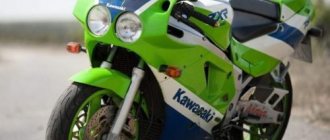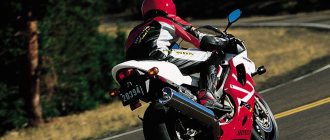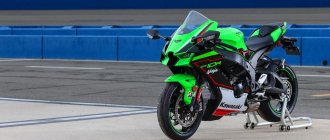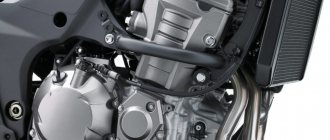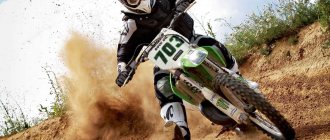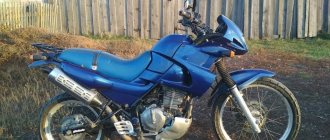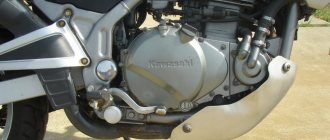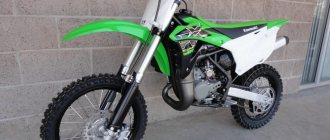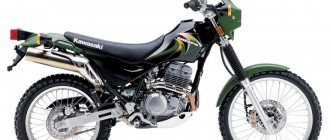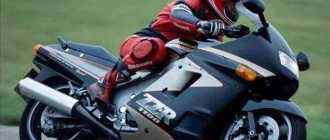- motorcycle model, Kawasaki brand
The Kawasaki GPZ 1100 sports tourer model was first presented in 1994 at an exhibition in Cologne, and official production and sales started in 1995. The model is a reincarnation of the motorcycle of the same name, produced from 1983 to 1985 (factory designation - ZX1100A), as well as a cheaper and more touring version, built on the basis of the flagship Kawasaki ZZ-R1100.
Featuring smoother engine tuning and a comfortable riding position, the Kawasaki GPZ1100 was equipped with a simple steel frame, simple suspension and 2-piston front brakes.
In 1996, the company offered a version of the Kawasaki GPZ1100 with ABS (such models were designated as ZX1100F, while the basic version was ZX1100E.)
The model was based on an in-line 4-cylinder liquid-cooled engine with a volume of 1052 cm³, producing up to 129 hp. power (for full-power European versions). The engine differs from the Kawasaki ZZ-R1100 engine in the absence of inertial boost, smaller carburetors, exhaust system and tuning for high performance at mid-range speeds.
The Kawasaki GPZ1100 was available in all major markets including North America, Europe, Australia and Japan.
1999 was the last year of production, after which the model finally left the markets and the GPZ1100 name was never used again.
Appearance
The difference in the design of the sports and sports-tourist versions is small. First of all, of course, the dimensions differ. A sportbike is shorter and not designed to be ridden by two. That is, this is physically possible, but it will be much safer for the passenger on the sports-touring Kawasaki GPZ 1100. The latter also has a container for things, which at the same time insures the rear passenger.
The car looks like a typical representative of the sports and sports-tourist classes of the end of the last century. Angular shapes, medium-height windshield, alloy wheels. Many bikes look like this model, so there is nothing unique about the appearance of the GPZ 1100.
This bike was available in silver, red and black colors. All three paint options work well for a sports tourer. However, many other colors would suit him just as well. The mirrors are moderately high, so they do not stand out in any way and serve a purely practical function.
If you compare both options from the photo, you won’t find much difference except the length and the rear seat. So if you want an old sports-class motorcycle and plan to ride it alone and not far, a sportbike is quite suitable.
Review of the Kawasaki GPZ 1100 (ZX1100E-F) motorcycle
I’ve been using this bike for the second season now (my mileage is about 30,000 km), the speedometer shows just over 50,000, and in principle I don’t notice any serious problems with it. Well, yes, the engine is NOISY (just like all CAVs) and yes, it’s HEAVY (but it’s a tourist and not a sport).
and in two years of operation it has never let me down! Its large weight is a plus, it doesn’t drift on the road, it handles like a bicycle, it’s quite reliable, it has a very comfortable seating position, it has low fuel consumption (I compare it to a blackbird (my previous bike)) and very smooth thrust from the engine,
The suspension has never been punctured, although I often ride with number two around the region and I have 120 kg
in general, whoever decides to take it for long trips will make you happy!
I’ll start with the seating position, for a tall person (195 cm) it’s simply gorgeous, it doesn’t stiffen at all, the hands don’t get tired, the passenger is also extremely happy, because the rear sofa is not suitable for sleeping or for other activities (or rather, it’s not as comfortable as on sofa). The rider doesn’t get tired even after a long ride, you don’t notice 100 km, but when riding to Taman, which is more than 270 km at an average speed of 160-200, I was the only one who wasn’t tired on my sports tour, the guys on the sports tour were exhausted. Wind protection is at a high level, so you won’t be in danger of pumping up your neck.
The engine is distinguished by excellent traction in any gear, out of 150 horsepower the device was left with 120 horsepower, making it not so sharp and sporty, the name sport-tourist must be said with greater emphasis on the tourist, because the engine is not very aggressive for a kilogram, of course, although 600s like Yamaha R6 allows you to overtake “with difficulty and not with little”. His appetite for oil and gasoline is really pure kilograms))), the average gasoline consumption per hundred fluctuates from 8 to 12 liters, you need to keep an eye on the oil, you don’t think that taking a motorcycle with a mileage of 30-50 thousand km is the first round ? For 1000 km you will have to add 100-200 grams, how to unscrew it. In fact, oil consumption is its only soreness (OR I GOT THIS), but the bike willingly feeds not only on Motul 7100. It is failure to monitor the oil that leads to frequent deaths of engines of both ZZRA and other liters: either the liners will turn, then the knee will close and etc. It's so difficult to straighten the bike and check the oil level before starting the bike. In fact, this model does not have ZZR's problems.
The transmissions are a bit short, which is not surprising for a tourist. What pleased me was the suspension - it’s soft and at the same time allows you to enter turns by touching your knee; driving over buoys and rocky roads does not cause any inconvenience. On the highway you can relax, here the bike is in its element, with soft suspension, good wind protection and with a considerable weight of 200 kg, you feel like on a steamship, there is enough gas and traction for any overtaking, it holds the road like a steam locomotive on rails. In the city you don’t feel inferior either, the bike handles great, pulls great from the very bottom, and thanks to the not too inflated body kit, squeezing between cars is quite easy.
Special words of gratitude to the mixed oil-water cooling system. Even on the hottest days, when the air temperature was over 45 degrees, in traffic jams, it did not warm up above 90 degrees. The rare switching on of the huge fan was so short-lived that suspicions about its serviceability sometimes crept in. Although it is not so easy to deploy this embrasure in the city, the bike cannot be recommended for people of short stature and puny build. One of the few kilograms that can forgive the rider his mistakes (not too big). Good brakes for such a kid. Getting a motorcycle stuck even from the clutch is a fantasy task.
True, not the whole story is so good, there were some mistakes, when the needles were covered and in the morning the mood was spoiled by the sight of the bike in a huge puddle of gasoline, but in the evening I filled in 20 liters ((. The most offensive thing happened again the next morning, when I realized that the faucet was also not working holds it, and the neighbor sarcastically joked that nowadays they wash asphalt with gasoline.
Summing up, we can say that the motorcycle is, of course, slightly outdated, and the design cannot be called modern; the high weight and small number of horses do not allow it to compete with its peers from the sports league, but also allow it not to lag far behind them. Pure sports tour as it should be.
I didn’t plan to buy this particular motorcycle, but everything happened spontaneously, as always, and so…. hop... I am the owner of GPZ. I got it in 1995. for 120 tyr two years ago, i.e. this season will be the third. The moto was in good condition. So I sat down and went. It rushes like a motorcycle with an engine capacity of 1100 cm3, produced in 1995. 147 horses are enough for me (the full-power version).
hop... I am the owner of GPZ. I got it in 1995. for 120 tyr two years ago, i.e. this season will be the third. The moto was in good condition. So I sat down and went. It rushes like a motorcycle with an engine capacity of 1100 cm3, produced in 1995. 147 horses are enough for me (the full-power version).
The speedometer is in miles, the last number is 180. The needle reached 160 and a little more. Comfortable highway speed for me is 100-130 miles. In terms of dimensions, the GPZ is narrower than the ZZR, which in my opinion is more convenient in a traffic jam, and I make my way through it every morning on the way to work from Bataysk to Rostov.
By the way, with my height (198 cm), I feel quite normal on the GPZ. The GPZ can be ridden either with a straight seat or in the “fetal position”, which is why it is a sport-tourist.
We have almost all consumables in our store, with the exception of the air filter. HUGE respect to Belka for the air filter!!!
I pour Liquimol oil, somehow it was all wrong on Motul... last year I tried to fill it with 7100 10W/40, so I drove it a little over a thousand and drained it...
The box crunches... what did you expect from Kawasaki? It crunches when switching from first to second, but all the others seem to turn on normally. Pah-pah-pah…. in two seasons on GPZ, my only plate broke ... well, you understand why.
It crunches when switching from first to second, but all the others seem to turn on normally. Pah-pah-pah…. in two seasons on GPZ, my only plate broke ... well, you understand why. But now I can solder plastic perfectly
But now I can solder plastic perfectly
I’m not going to sell the bike yet - I’m completely satisfied with it. Although, if there is someone who wants to take it from me for 200-250 thousand, I’ll think about it 
Comfort
The car starts quite quickly, which is convenient for those who know how to handle fast bikes. A good choice for motorcyclists who have already mastered road and touring motorcycles and now want to try something sporty. Such people are already ready for relatively high speeds and the heavy weight of the bike.
Due to the fact that the drive is chain, the noise level is of course noticeable. However, it cannot be said that it hurts the ears or is excessively loud. At high speeds, the noise of gear shifting, as well as the noise of the engine, will be less audible due to the wind.
The windshield provides sufficient protection from air currents, which become noticeable after accelerating to approximately 130 km/h. So for a comfortable and safe ride above this indicator, the rider should bend down. The instrumentation is easy to read, which is natural given the height of the front end of this Kawasaki motorcycle.
Video
Produced from 1990 to 1996, the Kawasaki ZZR 1100, also known as the ZX11 Ninja, managed to leave an indelible mark on history. This motorcycle is a real king of the highways, capable of overtaking almost anyone with a casual twist of the right handle towards itself, and it embodies everything that is now called the standard sports tourer
Although there was a fly in the ointment - according to reviews from ZZR 1100 owners, the weak point of this motorcycle is its reliability, but for a touring bike this is extremely important
The main drawback that owners complain about migrated to the ZZR 1100 straight from the younger Zizers - Kawasaki ZZR 400 and Kawasaki ZZR 600. The operation of the motorcycle transmission causes complaints. The six-speed gearbox is good, no doubt, but its design is such that after a couple of tens of thousands of kilometers it becomes loose, and the clarity of gear shifting disappears, and besides, sometimes the most famous problem of all Zizers comes to light - the second gear falling out
Timely maintenance and increased attention to the condition of the transmission, however, can reduce the risk of such troubles to a minimum. Kawasaki ZZR 1100The Kawasaki ZZR 1100 engine is one of its main advantages. The liquid-cooled in-line four produces from 140 to 147 horsepower depending on the year of manufacture, and 105-110 nm of torque, which makes this motorcycle not just fast, but very fast
It is capable of both taking off at breakneck speed and squealing tires, and powerfully accelerating, for example, from 150-180 km/h. The maximum speed of the Kawasaki ZZR 1100 is impressive - 285 kilometers per hour. The characteristics of the bike allow him to control the situation at almost any speed.
The motorcycle has an aluminum frame, diagonal type, quite reliable, but sometimes a problem arises with the subframe. If you suddenly decide to buy a Kawasaki ZZR 1100, inspect this place - on some copies the subframe may be cracked. You can find this out by throwing off the seat and looking under the plastic of the tail section. By the way, about the suspensions - they are different for the ZZR 1100 before 1993 and after the 1993 model year, with positive changes for more recent motorcycles, since in 1993 the suspension became adjustable. Kawasaki ZZR1100 Here you can add a fly in the ointment. Where the 600 cc Zizer can be given a plus for its suspension, the Kawasaki ZZR 1100 will receive only a minus, since the front fork is rather weak for its weight and acceleration dynamics, and during sharp braking it twists noticeably. And this motorcycle is quite capable of braking sharply; three brake discs stop it quite quickly.
This motorcycle is certainly very good, but it is also controversial. Excellent acceleration dynamics, a solid power reserve and a high level of comfort are combined with the low reliability of some components and a comfortable, but rather weak suspension. In view of this, future owners of used Kawasaki ZZR 1100 should carefully inspect their potential purchase for problems with the transmission, subframe and souring brakes. The ZZR 1100 is a simply excellent motorcycle, but it requires a very careful and careful attitude. If you are ready to put up with the “delicacy” of its design for the sake of its impressive characteristics, take a closer look at it; fortunately, it is quite inexpensive on the secondary market.
Dimensions and weight
This is perhaps the main difference between the two versions of the Kawasaki GPZ 1100. This to some extent affects the dynamic performance and comfort of use in certain situations. In addition, this also affects maneuverability.
Here are the dimensions of the sportbike:
- weight – 230 kg;
- seat height – 790 mm;
- tank volume – 20 l.
The dimensions of the sports tourist are as follows:
- weight – 242 kg;
- seat height – 795 mm;
- tank volume – 22 l.
In both cases, the dimensions and weight correspond to the standards of the class and allow you to fully experience its advantages.
The lighter sport option is better suited to an urban environment, and the sport tourer is a great choice for a traveling couple who loves fast bikes.
Specifications
The models are not very different in this regard, but there is a difference. And it is definitely worth taking into account, even if the other differences are not fundamental.
| Motor type | in-line, 4 stroke, 4 cylinders |
| Power | sportbike: 120 hp sport tourer: 125 hp |
| Torque | 100 Nm |
| Maximum speed | sport bike: 240 km/h sports tourer: 254 km/h |
| Acceleration to 100 | 3.4 s |
| Fuel consumption per hundred | 7.1 l |
| Drive unit | chain |
| Transmission | sport: five-speed sport-touring: six-speed |
| Frame | steel |
| Rear suspension | monoshock with progression sport: travel 109 mm sport-tourer: travel 125 mm |
| Front suspension | telescopic fork sport: 37 mm, travel 150 mm sport-tourer: 41 mm, travel 120 mm |
| Rear brakes | 1 disc, 1 piston caliper sport: 236 mm sporturist: 250 mm |
| Front brakes | 2 disks sport: 236 mm, 1-piston calipers sporturist: 300 mm, 2-piston calipers |
The technical characteristics of both motorcycles are at the same level. Even today they look the part, allowing these Kawasakis to compete successfully with modern bikes.
Video
Kawasaki ZZR 1200
- a solid sports tourist for those who have nowhere to rush. Yes, yes, that’s such an oxymoron. This powerful, heavy and imposing motorcycle is elegantly suited for traveling with maximum comfort and at high average speeds, but it may disappoint fans of an aggressive riding style - the ZZR 1200 does not like excessive fussiness. But it’s easy to take you wherever you want quickly and with all the comforts; he’s a master at this. Representing a further development of the previous model in the series, the Kawasaki ZZR 1100, the 1200 cc “Zizer” is in many ways similar to it, and, admittedly, first of all, the descendant borrowed its advantages from its predecessor. We can safely say that the ZZR 1200 is a worthy successor to the good traditions of the Kawasaki ZZR 400 and ZZR 600. Kawasaki ZZR 1200 Like its predecessor, the 1200 cc Zizer boasts an excellent engine that can accelerate a heavy motorcycle to 280 kilometers per hour. Power - 149 hp, torque - 109 nM. Impressively, this engine has one minor but unpleasant drawback - in any gear around 4000 rpm there is a short-term dip in the torque curve. However, you can get used to this. By the way, despite the fact that the Kawasaki ZZR 1200 is a modern motorcycle, it nevertheless uses a carburetor power supply instead of an injector in the old fashioned way. By the way, getting to the carburetors on your own is not so easy.
With the exception of the aforementioned dip in power, the ZZR 1200's engine is smooth and calm, but only until it reaches peak torque - at which point the already monstrously powerful bike seems to get a second wind, so you have to be with be careful with him. The vibrations of the motor are noticeable, but do not cause any inconvenience. The top, sixth gear, if desired, can be engaged already at 100-110 km/h - thanks to the enormous power, the Kawasaki ZZR 1200 will easily pick up the desired speed. The suspension and frame of the Kawasaki ZZR 1200 are in many ways similar to those on the 1100 cc Zizer of recent years of production. The aluminum frame with steel elements behaves well in corners, the suspension allows you to adjust the damping and preload, but the front fork seems rather weak for sharp maneuvers, and hints at this at the first intense braking, when the fork noticeably twists. As we noted above, the Kawasaki ZZR 1200 is not one of those motorcycles that likes to be ridden aggressively, despite its solid power.
Kawasaki ZZR1200But even if you don't like sharp maneuvers, high power requires good brakes. Everything is in order here - modern disc brakes stop the ZZR 1200 powerfully and efficiently, despite the rather heavy weight of the motorcycle (dry weight - 236 kilograms). At the same time, the braking system is very friendly; it distributes the braking force smoothly, without sudden jumps that can make any motorcyclist nervous. We can say that the Kawasaki ZZR 1200 is the same ZZR 1100, only better, and without some of its shortcomings. The next stage of development is the Kawasaki ZZR 1400, but it costs quite a lot, so the 1200th “Zizer” is able to help out the sports tourist enthusiast - it costs significantly less than its older brother, and at the same time is an excellent bike for traveling on normal asphalt .
History of changes
The sportbike has undergone the following evolution:
- In the first year of production, 1981, the B1 generation emerged.
- The B2 generation appeared in 1982, the engine was painted chrome-plated black, a new fairing was installed, and the instrument panel included liquid crystal display elements. The analogue injection system is also being changed to digital. The suspensions are getting stiffer.
- In 1983, the A1 generation was released. An anti-dive fork is added, and the rear suspension is changed to progressive.
- A2 was released in 1984. The changes are only “cosmetic”.
- 1985 was the last year of production of the sports version. This is the A3 generation. However, there were no changes here.
The sports tourist does not have a history of change as such. The motor is the same type, but different in characteristics. It is borrowed from the Kawasaki ZX-11. No changes were required here. The concept was exhausted.
